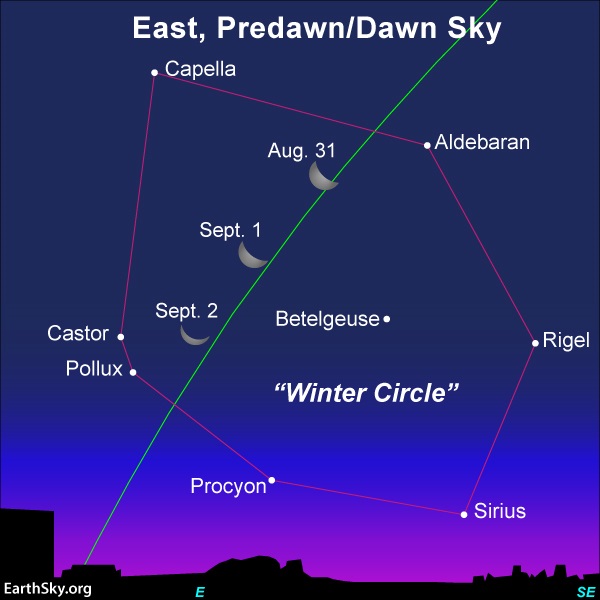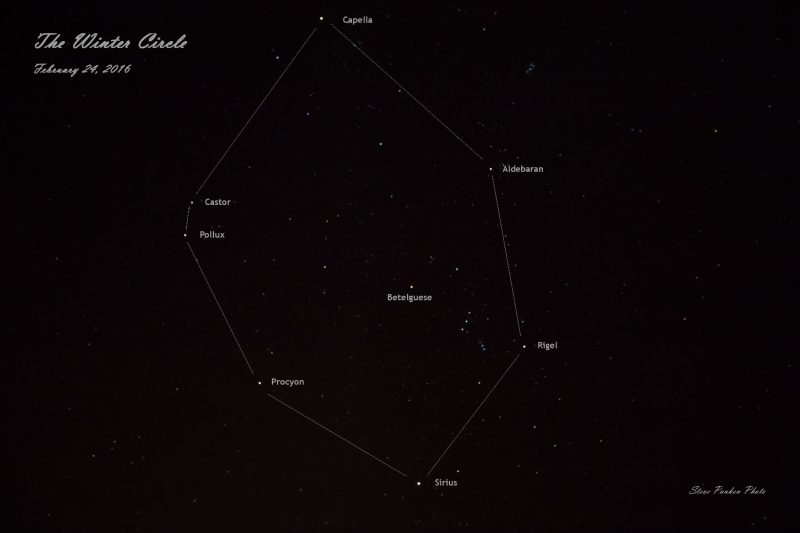
Although it’s summer in the Northern Hemisphere, a major sign of winter looms large now in the predawn sky. The waning crescent moon can guide your eye to this large lasso of stars – the Winter Circle – on mornings in in late August and early September 2021.
The Winter Circle is sometimes called the Winter Hexagon. It’s not a constellation, but instead is an asterism, or recognizable pattern of stars. It consists of six stars in six different constellations that are associated with the winter sky for us in the Northern Hemisphere (the summer sky for the Southern Hemisphere).
Winter Circle’s 6 (or 7) bright stars
Do you know the constellation Orion the Hunter? It’s one of the best-known constellations in the night sky. Orion is big, but the Winter Circle is much bigger! Orion is in the southwest portion of the Winter Circle (lower right on our chart above). If you’ve never seen the Winter Circle, but are acquainted with Orion, this constellation presents a great jumping off place for identifying these stars.
So look at our chart above and notice the star Rigel in Orion. Then start moving around the Circle clockwise. You’ll encounter Sirius in the constellation Canis Major the Big Dog, Procyon in the constellation Canis Minor the Smaller Dog, Pollux (and Castor) in the constellation Gemini the Twins, Capella in the constellation Auriga the charioteer, and Aldebaran in the constellation Taurus the Bull. All of these stars are what astronomers call 1st-magnitude star. And that means they’re bright and easy to see.
The exception is the star Castor in Gemini. It’s not a 1st-magnitude star and not as bright as the other stars in the Winter Circle. But it’s pretty bright! It’s the sky’s brightest 2nd-magnitude star. If you include Castor as a Winter Circle star, then there are seven stars in the Circle.

The ecliptic passes through Winter Circle
The green line on the sky chart at top depicts the ecliptic. That’s Earth’s orbital plane projected onto the sky. The ecliptic marks sun’s yearly pathway in front of the constellations of the zodiac. The moon travels along the ecliptic, too. And the ecliptic cuts right through the Winter Circle. That’s why we often see the moon cutting a path through this Circle of stars.
By the way, we don’t see the Winter Circle in June and July because it’s lost in the glare of the sun. In late August, the Winter Circle returns to the morning sky. Some months from now, when it’s the Northern Hemisphere’s winter, we’ll see Winter Circle in the evening sky.
Bottom line: The moon will be passing through the Winter Circle from August 31 to September 2, 2021. Look east before dawn
The post See the Winter Circle before dawn first appeared on EarthSky.
from EarthSky https://ift.tt/3gI2Pnr

Although it’s summer in the Northern Hemisphere, a major sign of winter looms large now in the predawn sky. The waning crescent moon can guide your eye to this large lasso of stars – the Winter Circle – on mornings in in late August and early September 2021.
The Winter Circle is sometimes called the Winter Hexagon. It’s not a constellation, but instead is an asterism, or recognizable pattern of stars. It consists of six stars in six different constellations that are associated with the winter sky for us in the Northern Hemisphere (the summer sky for the Southern Hemisphere).
Winter Circle’s 6 (or 7) bright stars
Do you know the constellation Orion the Hunter? It’s one of the best-known constellations in the night sky. Orion is big, but the Winter Circle is much bigger! Orion is in the southwest portion of the Winter Circle (lower right on our chart above). If you’ve never seen the Winter Circle, but are acquainted with Orion, this constellation presents a great jumping off place for identifying these stars.
So look at our chart above and notice the star Rigel in Orion. Then start moving around the Circle clockwise. You’ll encounter Sirius in the constellation Canis Major the Big Dog, Procyon in the constellation Canis Minor the Smaller Dog, Pollux (and Castor) in the constellation Gemini the Twins, Capella in the constellation Auriga the charioteer, and Aldebaran in the constellation Taurus the Bull. All of these stars are what astronomers call 1st-magnitude star. And that means they’re bright and easy to see.
The exception is the star Castor in Gemini. It’s not a 1st-magnitude star and not as bright as the other stars in the Winter Circle. But it’s pretty bright! It’s the sky’s brightest 2nd-magnitude star. If you include Castor as a Winter Circle star, then there are seven stars in the Circle.

The ecliptic passes through Winter Circle
The green line on the sky chart at top depicts the ecliptic. That’s Earth’s orbital plane projected onto the sky. The ecliptic marks sun’s yearly pathway in front of the constellations of the zodiac. The moon travels along the ecliptic, too. And the ecliptic cuts right through the Winter Circle. That’s why we often see the moon cutting a path through this Circle of stars.
By the way, we don’t see the Winter Circle in June and July because it’s lost in the glare of the sun. In late August, the Winter Circle returns to the morning sky. Some months from now, when it’s the Northern Hemisphere’s winter, we’ll see Winter Circle in the evening sky.
Bottom line: The moon will be passing through the Winter Circle from August 31 to September 2, 2021. Look east before dawn
The post See the Winter Circle before dawn first appeared on EarthSky.
from EarthSky https://ift.tt/3gI2Pnr

Aucun commentaire:
Enregistrer un commentaire